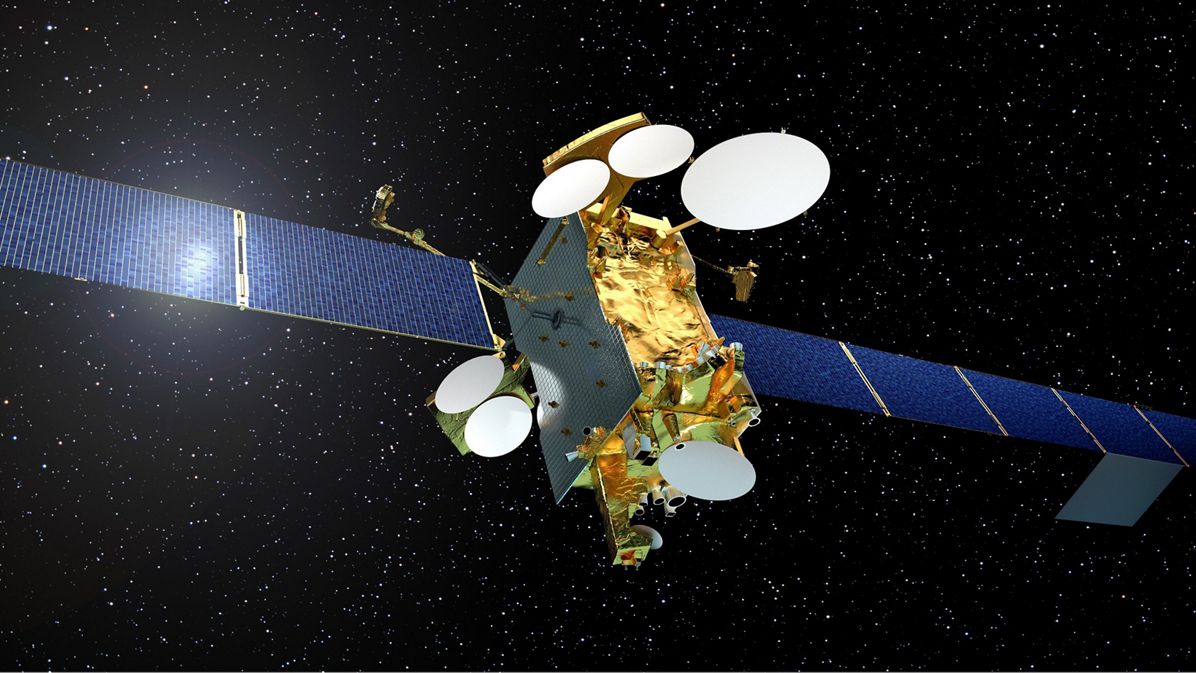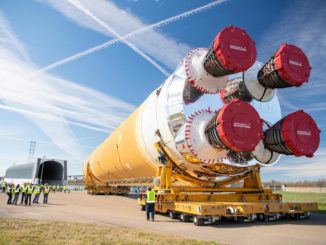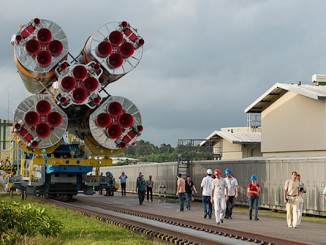EDITOR’S NOTE: Updated at 1300 GMT (8 a.m. EST) Jan. 26 with SES statement.

KOUROU, French Guiana — A European Ariane 5 rocket took off from French Guiana and delivered two commercial communications satellites and a NASA scientific package to orbit Thursday after an unexpected radio blackout raised worries that the mission failed. But questions lingered early Friday about the accuracy of the payload deployments.
The mission began with an on-time liftoff from the Guiana Space Center on the northern coast of South America. A pair of commercial communications satellites, named SES 14 and Al Yah 3, were mounted on the Ariane 5 for liftoff.
The Ariane 5 rocket concluded a smooth countdown with ignition of its hydrogen-burning Vulcain 2 engine at 2220 GMT (5:20 p.m. EST; 7:20 p.m. French Guiana time). Seven seconds later, after a computer-controlled readiness check, two solid rocket boosters fired to dispatch the Ariane 5 from its launch pad in Kourou, French Guiana.
Climbing through scattered clouds with 2.9 million pounds of thrust, the 180-foot-tall (55-meter) Ariane 5 arced to the east on a course over the Atlantic Ocean.
The Ariane 5’s two side-mounted boosters consumed more than a million pounds (480 metric tons) in the first two-and-a-half of the mission, then dropped away to fall into the Atlantic.
The range operations director inside the Jupiter control center at the European-run spaceport announced the separation of the Ariane 5’s Swiss-made payload shroud during the fourth minute of the flight, and confirmed shutdown of the first stage’s Vulcain 2 engine and separation of the spent liquid-fueled core.
A few seconds later, the launch team at in the Jupiter control room announced ignition of the Ariane 5’s upper stage HM7B engine, which consumes the same liquid hydrogen and liquid oxygen mixture as the first stage.
But the Ariane 5 disappeared over the horizon at the Kourou space base a few seconds later. Officials never heard from it again as the Ariane 5 was programmed to burn its HM7B upper stage engine for nearly 16 minutes.
Live telemetry displayed on Arianespace’s live webcast and on status boards inside the Jupiter control center stopped showing the rocket’s altitude, downrange distance and velocity, and the range operations director — known by the French acronym DDO — did not announce further milestones.
Nevertheless, Arianespace’s launch broadcast commentator continued calling out flight milestones, such as ground station passes, second stage shutdown and separation of the SES 14 satellite, as if officials confirmed their completion.
But silence from the range operations director, coupled with the telemetry dropout suggested by Jupiter display board, suggested something was amiss.
Arianespace paused their live broadcast after officials were unable to determine the outcome of the mission following the expected release of the Al Yah 3 spacecraft.
Stephane Israel, the French launch provider’s chief executive, announced that the Ariane 5 suffered an anomaly in remarks around one hour after liftoff.
“We have had an anomaly on this launch,” Israel said in a brief address to VIPs and customer executives. “Indeed, we lost contact with the launcher a few seconds after ignition of the upper stage.”
He said that engineers could not confirm whether the SES 14 and Al Yah 3 satellites separated from the Ariane 5’s second stage.
“We know that there is no launch with no risk,” Israel said. “We know that launch is always difficult, and tonight Ariane 5 has had an anomaly, so let’s take time now to better understand the situation of the satellites.”
Israel apologized for the mishap before ending his remarks, but reports trickled in over the next hour suggesting the Ariane 5 may have dodged disaster.

Arianespace issued a written statement around three hours after liftoff to announce both of the mission’s payloads achieved orbit. Officials did not confirm whether the satellites were located in their targeted elliptical “supersynchronous” orbits.
It turns out none of the downrange tracking stations primed to receive telemetry from the Ariane 5 established contact with the rocket.
“A few seconds after ignition of the upper stage, the second tracking station located in Natal, Brazil, did not acquire the launcher telemetry,” the company said. “This lack of telemetry lasted throughout the rest of powered flight.
“Subsequently, both satellites were confirmed separated, acquired and they are on orbit. SES 14 and Al Yah 3 are communicating with their respective control centers. Both missions are continuing.”
The statement did not specify the orbital parameters for either satellite.
The Ariane 5’s guidance computer aimed to deploy SES 14 and Al Yah 3 satellites into an orbit with a high point of 28,107 miles (45,234 kilometers), a targeted low point of 155 miles (250 kilometers) and an inclination of 3 degrees.
The far point of the Ariane 5’s intended drop-off orbit was more than 5,000 miles (more than 9,000 kilometers) above the altitude typically targeted on an Ariane 5 launch carrying a commercial geostationary satellite.
Officials said they chose the “supersynchronous” transfer orbit to reduce the time and fuel needed for the satellites to reach their operating posts.
Sources familiar with the launch said the SES 14 and Al Yah 3 spacecraft were have been delivered to the exact orbits targeted by the Ariane 5, but officials shared no specifics on the orbital parameters Thursday night.
The SES 14 and Al Yah 3 satellites were designed to use on-board thrusters to maneuver themselves into circular orbits 22,300 miles (35,800 kilometers) over the equator.
With the benefit of an electric thruster orbit-raising package, the SES 14 telecom satellite is expected to be able to reach its planned position in geostationary orbit without major impacts to its mission, a space industry official said. The low-thrust, high-efficiency electric thrusters take more time to make big changes to a satellite’s orbit, but they can fire for longer durations than conventional chemical rocket engines.
Luxembourg-based SES issued a press release Friday declaring the SES 14 satellite was “in good health” following the launch and should be able to complete its mission.
“Following the anomaly that occurred during the launch on an Ariane 5 rocket last night, SES announces that it has successfully established a telemetry and telecommand connection to its SES 14 spacecraft and is setting up a new orbit-raising plan now,” SES said in a statement. “SES 14 would thus reach the geostationary orbit only four weeks later than originally planned. SES confirms that the spacecraft is in good health, all subsystems on board are nominal, and the satellite is expected to meet the designed life time.”
Assuming an on-target deployment from the Ariane 5, SES 14 was expected reach geostationary orbit by August or September, officials said before Thursday’s launch.
The outlook for the Al Yah 3 satellite, which has a chemical orbit-raising thruster, has not been confirmed.
The larger of the two payloads, SES 14, rode in the upper position in the dual-payload stack Thursday. Built on the Airbus Eurostar E3000 satellite bus, the 9,751-pound (4,423-kilogram) spacecraft will provide aeronautical and maritime mobility connectivity, wireless communications, broadband delivery, and video and data services over North, Central and South America, the Caribbean, the North Atlantic and parts of Europe, replacing the NSS-806 satellite for SES of Luxembourg.
The craft hosts a secondary payload for NASA named the Global-scale Observations of the Limb and Disk, or GOLD, instrument. The $53 million GOLD instrument will study the ionosphere and thermosphere layers in the upper atmosphere, where influences from solar activity and Earth-based weather systems combine to affect communications and navigation around the world.
SES 14 was built for a position in geostationary orbit around 47.5 degrees wast longitude.
The Al Yah 3 communications satellite, manufactured by Orbital ATK, launched in the lower position in the Ariane 5’s dual-payload berth. The 8,366-pound (3,795-kilogram) spacecraft is owned by Al Yah Satellite Communications Co. based in Abu Dhabi, and it will be parked at 20 degrees west longitude in geostationary orbit.
Al Yah 3 is the first in a new generation of higher-power, larger telecom satellites built by Orbital ATK. The new GEOStar 3 design adds additional capability to Orbital ATK’s previous GEOStar 2 spacecraft platform.
The spacecraft will support broadband Internet and data services over Africa and Brazil.
Both satellites were designed for missions of at least 15 years, while the GOLD instrument has a two-year mission lifetime.
If officials confirm the Ariane 5 delivered SES 14 and Al Yah to an off-target orbit, the setback would end a streak of 82 straight flawless Ariane 5 flights, one of the world’s best launch records.
Thursday night’s launch was the first of seven Ariane 5 missions planned by Arianespace this year.
Two more commercial dual-payload flights are on tap for March and April, followed by an Ariane 5 flight in July with four more Galileo navigation satellites.
Two flagship scientific missions are reserved for Ariane 5 launches in October and early 2019.
BepiColombo will kick off a seven-year journey to Mercury when it lifts off Oct. 5. The two BepiColombo spacecraft built in Europe and Japan will survey the solar system’s innermost planet’s geology, evolution and magnetic field.
And the $10 billion James Webb Space Telescope — a joint NASA-ESA-Canadian observatory — is set to follow with a launch on an Ariane 5 rocket in early 2019.
Email the author.
Follow Stephen Clark on Twitter: @StephenClark1.



